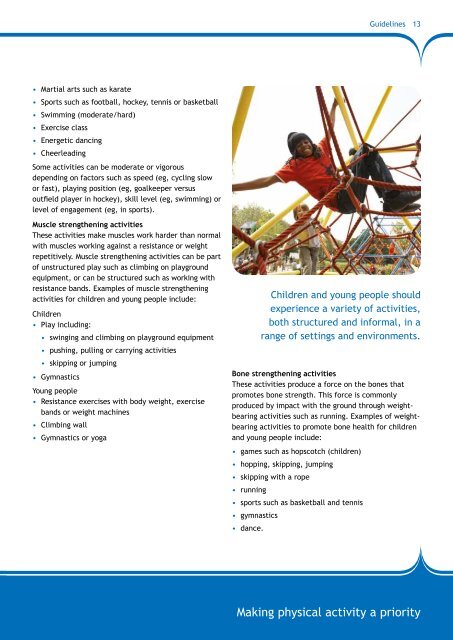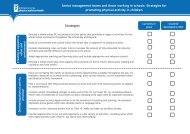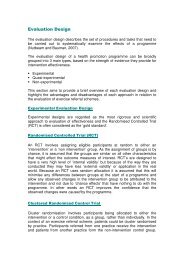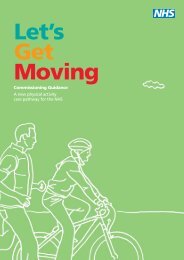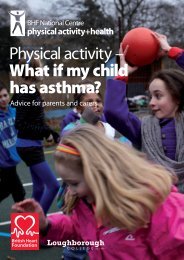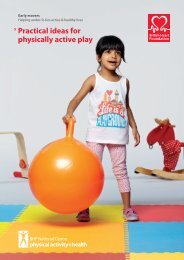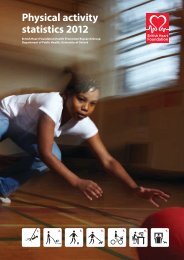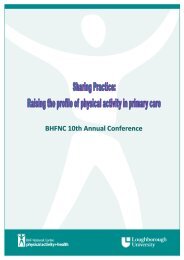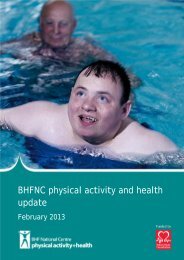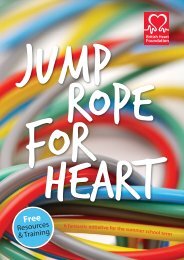Interpreting the UK physical activity guidelines for children and ...
Interpreting the UK physical activity guidelines for children and ...
Interpreting the UK physical activity guidelines for children and ...
You also want an ePaper? Increase the reach of your titles
YUMPU automatically turns print PDFs into web optimized ePapers that Google loves.
Guidelines<br />
13<br />
• Martial arts such as karate<br />
• Sports such as football, hockey, tennis or basketball<br />
• Swimming (moderate/hard)<br />
• Exercise class<br />
• Energetic dancing<br />
• Cheerleading<br />
Some activities can be moderate or vigorous<br />
depending on factors such as speed (eg, cycling slow<br />
or fast), playing position (eg, goalkeeper versus<br />
outfield player in hockey), skill level (eg, swimming) or<br />
level of engagement (eg, in sports).<br />
Muscle streng<strong>the</strong>ning activities<br />
These activities make muscles work harder than normal<br />
with muscles working against a resistance or weight<br />
repetitively. Muscle streng<strong>the</strong>ning activities can be part<br />
of unstructured play such as climbing on playground<br />
equipment, or can be structured such as working with<br />
resistance b<strong>and</strong>s. Examples of muscle streng<strong>the</strong>ning<br />
activities <strong>for</strong> <strong>children</strong> <strong>and</strong> young people include:<br />
Children<br />
• Play including:<br />
• swinging <strong>and</strong> climbing on playground equipment<br />
• pushing, pulling or carrying activities<br />
• skipping or jumping<br />
• Gymnastics<br />
Young people<br />
• Resistance exercises with body weight, exercise<br />
b<strong>and</strong>s or weight machines<br />
• Climbing wall<br />
• Gymnastics or yoga<br />
Children <strong>and</strong> young people should<br />
experience a variety of activities,<br />
both structured <strong>and</strong> in<strong>for</strong>mal, in a<br />
range of settings <strong>and</strong> environments.<br />
Bone streng<strong>the</strong>ning activities<br />
These activities produce a <strong>for</strong>ce on <strong>the</strong> bones that<br />
promotes bone strength. This <strong>for</strong>ce is commonly<br />
produced by impact with <strong>the</strong> ground through weightbearing<br />
activities such as running. Examples of weightbearing<br />
activities to promote bone health <strong>for</strong> <strong>children</strong><br />
<strong>and</strong> young people include:<br />
• games such as hopscotch (<strong>children</strong>)<br />
• hopping, skipping, jumping<br />
• skipping with a rope<br />
• running<br />
• sports such as basketball <strong>and</strong> tennis<br />
• gymnastics<br />
• dance.<br />
Making <strong>physical</strong> <strong>activity</strong> a priority


